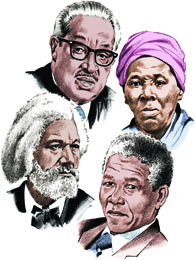Celebrating Black History Month

A time to reflect, remember and celebrate
lack History Month, or National African-American History Month, is an annual celebration of achievements by black Americans and a time for recognizing the central role of African-Americans in U.S. history. The event grew out of “Negro History Week,” the brainchild of noted historian Carter G. Woodson and other prominent African-Americans. Since 1976, every U.S. president has officially designated the month of February as Black History Month. Other countries around the world, including Canada and the United Kingdom, also devote a month to celebrating black history.
The story of Black History Month begins in 1915, half a century after the 13th Amendment abolished slavery in the United States. That September, Woodson, a Harvard-trained historian, and prominent minister Jesse E. Moorland founded the Association for the Study of Negro Life and History (ASNLH), an organization dedicated to researching and promoting achievements by black Americans and other peoples of African descent. Known today as the Association for the Study of African-American Life and History (ASALH), the group sponsored a national Negro History week in 1926, choosing the second week of February to coincide with the birthdays of Abraham Lincoln and Frederick Douglass. The event inspired schools and communities nationwide to organize local celebrations, establish history clubs and host performances and lectures.
In the decades that followed, mayors of cities across the country began issuing yearly proclamations recognizing Negro History Week. By the late 1960s, thanks in part to the Civil Rights Movement and a growing awareness of black identity, Negro History Week had evolved into Black History Month on many college campuses. President Gerald R. Ford officially recognized Black History Month in 1976, calling upon the public to “seize the opportunity to honor the too-often neglected accomplishments of black Americans in every area of endeavor throughout our history.”
Since then, every American president has designated February as Black History Month and endorsed a specific theme. The 2012 theme pays tribute to the ways in which black women have shaped the United States and its history.
Here are just a few other interesting facts about Black History Month:
The month of February was chosen to coincide with the birthdays of Frederick Douglass and Abraham Lincoln.
On February 12, 2009, the NAACP marked its 100th anniversary. Spurred by growing racial violence in the early twentieth century, and particularly by race riots in Springfield, Ill., in 1908, a group of African-American leaders joined together to form a new permanent civil rights organization, the National Association for the Advancement of Colored People (NAACP). February 12, 1909 was chosen because it was the centennial anniversary of the birth of Abraham Lincoln.
Jack Johnson became the first African-American man to hold the World Heavyweight Champion boxing title in 1908. He held on to the belt until 1915.
John Mercer Langston was the first black man to become a lawyer in Ohio when he passed the Bar in 1854. When he was elected to the post of Town Clerk for Brownhelm, Ohio in 1855 Langston became one of the first African-Americans ever elected to public office in America. John Mercer Langston was also the great-uncle of Langston Hughes, famed poet of the Harlem Renaissance.
Thurgood Marshall was the first African-American ever appointed to the United States Supreme Court. He was appointed by President Lyndon B. Johnson, and served on the Supreme Court from 1967 to 1991.
George Washington Carver developed 300 derivative products from peanuts among them cheese, milk, coffee, flour, ink, dyes, plastics, wood stains, soap, linoleum, medicinal oils and cosmetics.
Hiram Rhodes Revels was the first African-American ever elected to the United States Senate. He represented the state of Mississippi from February 1870 to March 1871.
Shirley Chisholm was the first African-American woman elected to the House of Representatives. She was elected in 1968 and represented the state of New York. She broke ground again four years later in 1972 when she was the first major party African-American candidate and the first female candidate for president of the United States.
The black population of the United States in 1870 was 4.8 million; in 2007, the number of black residents of the United States, including those of more than one race, was 40.7 million.
In 1940, Hattie McDaniel was the first African-American performer to win an Academy Award (the film industry`s highest honor) for her portrayal of a loyal slave governess in Gone With the Wind.
In 1992, Dr. Mae Jemison became the first African-American woman to go into space aboard the space shuttle Endeavor. During her eight-day mission she worked with U.S. and Japanese researchers, and was a co-investigator on a bone cell experiment.



























